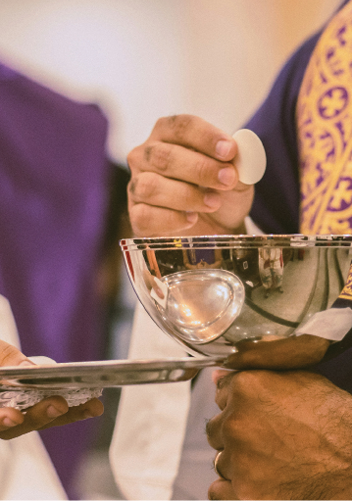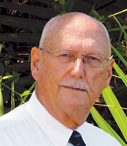Ever wonder why we Lutherans use the form of worship we do? In this series we examine the depth and meaning of the various elements of our Lutheran worship service.

“And as they were eating, Jesus took bread, blessed and broke it, and gave it to the disciples and said, ‘Take, eat; this is My body.’ Then He took the cup, and gave thanks, and gave it to them, saying, ‘Drink from it, all of you. For this is My blood of the new covenant, which is shed for many for the remission of sins.'” (Matthew 26:26-28)
To faith, these words of Jesus are simple; to human reason, impossible.
Without going into the complexities of hermeneutics (the scholarly interpretation of language, especially the words of Scripture), suffice it to say we believe that in the Lord’s Supper we receive the true body and true blood of the Savior Jesus Christ “in, with, and under” the visible and tangible elements of bread and wine.
So then, what happens when we commune? The Lord’s Supper is a means of grace, instituted by Christ, the Son of God, through which we receive forgiveness of sins. How can that possibly be? It can be because Jesus says so. It doesn’t make sense to human reason—which no doubt is why so many deny that effect and interpret the whole thing as merely a symbolic act of remembrance. Nonetheless, we accept by faith the clear words of Jesus that what we receive along with the bread and wine is His body and blood, and that in that reception the Holy Spirit is active to forgive our sins and strengthen our faith for daily living. It is the working of God, and that alone, which produces that effect; we can only thank and praise Him for this great blessing of His grace.
The only essential parts of this sacrament are the use of Christ’s words in consecrating the bread and wine, and the distribution of the consecrated elements to the communicants. All other practices, so long as they are done decently and in good order, are matters of adiaphora (things neither commanded nor forbidden by God). Obviously, however, there must be some sort of liturgical structure to implement those two essential parts.
Confessional Lutherans seek to do all things in keeping with God’s Word, and we find—both historically and currently—a variety of liturgical practices. Lutheran liturgists have composed many different liturgies for the Sacrament of the Altar, each seeking to attain the goal of reverently reinforcing the nature and solemnity of the Lord’s Supper.
Usually, those liturgical details are well-considered; but sometimes—dare I assert this?—the suggestions of those who write books about liturgies may tend to encroach on Christian liberty. We must remember that other than the two essential elements of the Lord’s Supper, all else is adiaphora.
For just one example among many possible, this one in connection with whether to use a chalice or a chalice plus individual cups, one liturgy expert mentions that tradition calls for the common chalice alone to be used, because it is a symbol of Christian fellowship and the unity of which Paul speaks in 1 Corinthians 10:16-17. That part is a fitting comment. Unfortunately, he then goes on to say that if individual cups are also used, only the chalice should be on the altar for the consecration, and the individual cups should not be filled beforehand or placed on the altar. Rather, he says, the communicants who use individual cups should take the empty cups from a rack in the pew or from a cabinet at the entrance to the chancel, take those empty cups with them to the altar, and then have them filled from the chalice by the officiant. Certainly, there’s nothing wrong with following that suggestion, but binding consciences with adiaphora should be avoided.
In our liturgical practice and all else, the CLC seeks to uphold and practice God’s Word in a manner that glorifies God and edifies the believer without encroaching on Christian liberty. We thank our Lord for that blessing, and pray that it may continue among us. Amen.
is a retired teacher and serves as assistant editor of the Lutheran Spokesman. He lives in Cape Coral, Florida.


